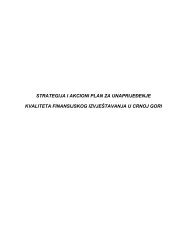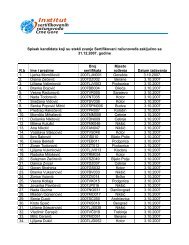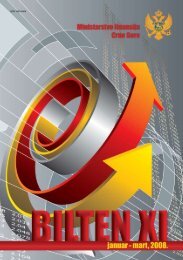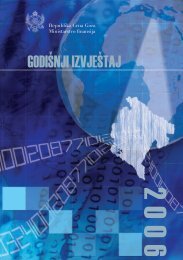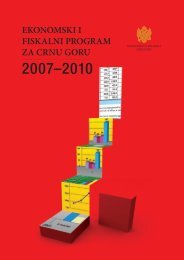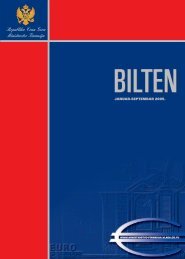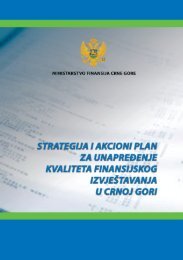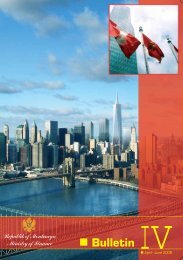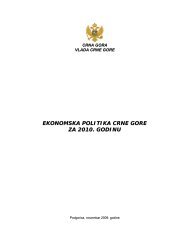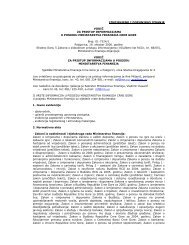Republic of Montenegro: Public Expenditure and ... - Vlada Crne Gore
Republic of Montenegro: Public Expenditure and ... - Vlada Crne Gore
Republic of Montenegro: Public Expenditure and ... - Vlada Crne Gore
You also want an ePaper? Increase the reach of your titles
YUMPU automatically turns print PDFs into web optimized ePapers that Google loves.
58 Chapter 4: <strong>Public</strong> Financial Management <strong>and</strong> Procurement<br />
audit, there is a need to exp<strong>and</strong> the IA functions beyond the Ministry <strong>of</strong> Finance <strong>and</strong> build<br />
capacity for internal audit within line ministries.<br />
4.6 This chapter is organized as follows. Section B discusses budget preparation issues, in<br />
particular the transparency <strong>and</strong> comprehensiveness <strong>of</strong> the budget, the reliability <strong>of</strong> the budget,<br />
program budgeting <strong>and</strong> medium term budget planning. Section C discussed budget execution <strong>and</strong><br />
cash management. Section D discusses public procurement. Section E focuses on internal <strong>and</strong><br />
external audits, <strong>and</strong> the last section <strong>of</strong>fers conclusions <strong>and</strong> recommendations.<br />
B. BUDGET FORMULATION<br />
4.7 <strong>Montenegro</strong>’s Organic Budget Law, adopted in 2001, provides a framework for<br />
budget formulation <strong>and</strong> execution. The Law assigns responsibilities to the Ministry <strong>of</strong> Finance<br />
(MoF) to issue detailed subordinate regulations to guide the processes. The MoF is responsible<br />
for managing the budget preparation process for the central government. The budgets <strong>of</strong><br />
municipalities <strong>and</strong> social funds are prepared by their respective bodies.<br />
4.8 The budget preparation process begins in June with the preparation <strong>of</strong> the<br />
macroeconomic <strong>and</strong> fiscal policy framework for the next fiscal year, which in turn defines<br />
the overall budget resource envelope. The MoF then issues circular instructions, for each<br />
spending agency <strong>and</strong> the formats for budget submission. The spending agencies then prepare<br />
their budgets according to the format provided by the MoF <strong>and</strong> submit their budgets to the MoF<br />
in September. Budget planning at the spending agencies is based mainly on historical costs <strong>and</strong><br />
future projected needs. The final budget allocation outcome would involve negotiations. After<br />
negotiations, budget analysts from the MoF work with the budget <strong>of</strong>ficer <strong>of</strong> the respective<br />
spending unit to fit dem<strong>and</strong>s within the approved level <strong>of</strong> spending. The consolidated draft<br />
budget is then approved by the Government <strong>and</strong> forwarded to the Parliament in November for<br />
voting. The voted budget is published in the <strong>of</strong>ficial Gazette to inform budget users <strong>and</strong> citizens<br />
<strong>of</strong> budget allocations.<br />
Transparency <strong>and</strong> Comprehensiveness<br />
4.9 <strong>Montenegro</strong>’s budget for 2005 contains tables with the consolidated budgets <strong>of</strong> the<br />
central government <strong>and</strong> social funds, <strong>and</strong> a new harmonized chart <strong>of</strong> accounts is being<br />
implemented that would allow for the consolidation <strong>of</strong> municipal budgets into the general<br />
government budget as well. The budget, however, is still not fully comprehensive as it does not<br />
include municipalities.<br />
4.10 In general, the Montenegrin budget presents a clear <strong>and</strong> detailed description <strong>of</strong><br />
planned spending for the budgeted year, as well as the macroeconomic <strong>and</strong> fiscal assumptions<br />
that underpin the spending proposal. The structure <strong>and</strong> clarity <strong>of</strong> budget documentation<br />
submitted to Parliament is essential to assure that budget decisions are transparent to the public.<br />
The budget is accompanied by very good narrative that explains some <strong>of</strong> the major changes from<br />
the previous year both on the revenue <strong>and</strong> the expenditure sides. A comprehensive summary<br />
table is included that shows the economic classification <strong>of</strong> revenues <strong>and</strong> expenditures for four<br />
years – the budget year, the current <strong>and</strong> prior years, <strong>and</strong> one year into the future. The same table<br />
shows the planned deficit <strong>and</strong> the levels <strong>of</strong> financing that will be required. There is detailed



